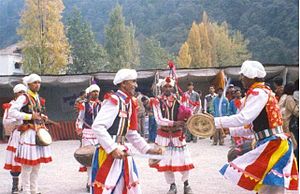- Mashak
-
The mashak (also known as masak, mishek, meshek, moshug, moshaq, moshuq, mashak bin, bin baji) is a type of bagpipe found in Northern India and parts of Pakistan and Afghanistan.[1] The pipe was associated with weddings and festive occasions.[2] In India it is historically found in Rajasthan and Uttar Pradesh.[3] This bagpipe uses single reeds,[4] and can be played either as a drone or as a melody instrument.[5]
Colonel James Tod (1782–1835 CE) notes in reference to the mashak that the Raja of Jind had a bagpipe band, with the players wearing kilts and pink legging in imitation of Scottish Highland pipers.[6]
Contents
Relation with the Scottish Highland pipes
 A Kumaoni bagpiper playing the masak-been as Chholiya Sword Dancers dance.
A Kumaoni bagpiper playing the masak-been as Chholiya Sword Dancers dance.
Some academics dispute any indigenous origins of the mashak; researcher Ander Burton Alter wrote in 2000 that the pipes today played in Garwhal are Scottish Highland bagpipes with one bass and two tenor drones, with no local manufacturer or evidence of existence prior to British rule in 1814.[7] Organologist Anthony Baines, however, described an intermediary development stage wherein Indian musicians imitated the Highland pipe by tying "an extra pipe or two" into their mashak.[8] Similarly, the New Grove Dictionary of Musical Instruments (1984) describes the traditional mashak as becoming rare as it is displaced by the Scottish pipes.[9]
Discography
- Various Artists – Footprints In The Desert... track Rajasthan's Bagpipe (Mashak). De Kulture
- Various – Music From The Shrines Of Ajmer and Mundra track Populat Naubat Shahna'i. Topic Records (UK), 1995
See also
- Titti (bagpipe), a Telugu bagpipe of Andhra Pradesh
- Sruti upanga, a drone bagpipe of Tamil Nadu
References
- ^ Royal Musical Association; Musical Association (Great Britain); International Musical Society; JSTOR (Organization), Taylor & Francis (1894). Proceedings of the Royal Musical Association. Royal Musical Association. pp. 64–. http://books.google.com/books?id=-8w5AAAAIAAJ&pg=PA64. Retrieved 16 May 2011.
- ^ Himal Associates (1993). Himāl. Himal Associates. p. 24. http://books.google.com/books?id=xcEWAQAAMAAJ. Retrieved 23 April 2011.
- ^ Andrew Alter. Garhwali Bagpipes: Syncretic Processes in a North Indian Regional Musical Tradition. Asian Music, Vol. 29, No. 1 (Autumn, 1997 - Winter, 1998), pp. 1-16. Published by: University of Texas Press, link at JSTOR.
- ^ Geneviève Dournon (May 2000). Handbook for the collection of traditional music and musical instruments. Unesco. p. 23. ISBN 9789231033049. http://books.google.com/books?id=kGgIAQAAMAAJ. Retrieved 23 April 2011.
- ^ Sibyl Marcuse (April 1975). A survey of musical instruments. Harper & Row. ISBN 9780060127763. http://books.google.com/books?id=-18IAQAAMAAJ. Retrieved 24 April 2011.
- ^ James Tod (1920). Annals and antiquities of Rajasthan: or The central and western Rajput states of India. H. Milford, Oxford University Press. pp. 755–. http://books.google.com/books?id=4CRuAAAAMAAJ&pg=PA755. Retrieved 23 April 2011.
- ^ Alter, Andrew Burton. 2000. Dancing the Gods: Power and Meaning in the Music of Garhwal, North India. Monash University, Victoria, Australia.
- ^ Anthony Baines (1979). Bagpipes. Pitt Rivers Museum. p. 56. http://books.google.com/books?id=a6MIAQAAMAAJ. Retrieved 23 April 2011.
- ^ Stanley Sadie (1984). The New Grove dictionary of musical instruments. Macmillan Press. ISBN 9780943818054. http://books.google.com/books?id=BGoYAAAAIAAJ. Retrieved 23 April 2011.
Categories:- Bagpipes
- Indian musical instruments
- Rajasthani music
Wikimedia Foundation. 2010.
